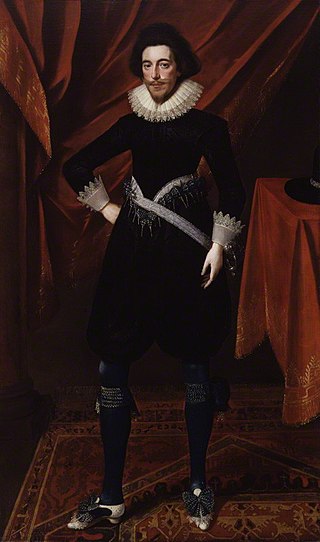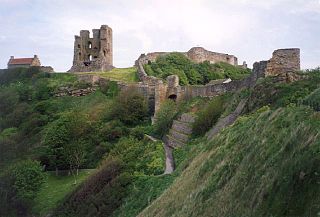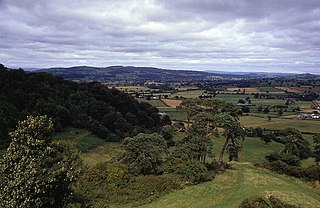
The Ironsides were troopers in the Parliamentarian cavalry formed by English political leader Oliver Cromwell in the 17th century, during the English Civil War. The name came from "Old Ironsides", one of Cromwell's nicknames. [lower-alpha 1]

The Ironsides were troopers in the Parliamentarian cavalry formed by English political leader Oliver Cromwell in the 17th century, during the English Civil War. The name came from "Old Ironsides", one of Cromwell's nicknames. [lower-alpha 1]
Cromwell first mustered a troop of cavalry (then referred to as "horse") at Huntingdon in Huntingdonshire, on 29 August 1642, early in the Civil War. John Desborough was quartermaster. The troop was late in being organised, and arrived too late to participate in the Battle of Edgehill, the first pitched battle of the war. Cromwell however did witness the defeat of the Parliamentarian horse at the battle and wrote to fellow Parliamentarian leader John Hampden,
Your troopers are most of them old decayed servingmen and tapsters; and their [the Royalists' ] troopers are gentlemen's sons, younger sons and persons of quality; do you think that the spirits of such base and mean fellows [as ours] will ever be able to encounter gentlemen that have honour and courage and resolution in them?[ citation needed ]
It is evident that Cromwell's answer to his own question lay in religious conviction. Early in 1643, he was given a commission as colonel and expanded his troop into a full regiment in the newly formed Army of the Eastern Association, under the command of Lord Grey of Warke and then the Earl of Manchester. By 11 September that year, he referred to them in a letter to his cousin Oliver St. John as a "lovely company". A champion of the "godly", Cromwell became notorious for appointing men of comparatively humble origins but stoutly-held Puritan beliefs as officers, who would then attract men of similar background and leanings to the regiment. He wrote to Sir William Spring, who disagreed with this policy,
I had rather have a plain russet-coated captain that knows what he fights for and loves what he knows, than that which you call a gentleman and is nothing else. I honour a gentleman that is so indeed.[ citation needed ]
On 28 July 1643, the regiment took part in the Battle of Gainsborough, where Royalist cavalry were defeated. One of the troop captains, James Berry, is stated to have killed the Royalist commander, Sir Charles Cavendish, a relation of the Marquess of Newcastle (Commander-in-Chief of the Royalist forces in the North).
The regiment's troops in 1643 were:
By April, 1644, after two years of war, Cromwell's unit had grown into a "double" regiment of no less than 14 troops. (A regiment normally had only 6 troops). Cromwell by this time was Lieutenant General of the Horse in the Parliamentarian Army of the Eastern Association, and the regiment would be routinely commanded by its lieutenant colonel, Cromwell's cousin Edward Whalley. The regiment played a major part in the victory over the Royalists at the Battle of Marston Moor, where the discipline of Cromwell's wing of horse was decisive. Where a victorious wing of Royalist cavalry scattered in search of plunder, Cromwell's men rallied after defeating their immediate opponents, and then swept the disordered Royalist armies from the field. Captain Valentine Walton, Cromwell's nephew, died of wounds after a cannon shot smashed his leg during the battle.
It was a different story by the time of the Second Battle of Newbury later that year. The Parliamentarian high command of Sir William Waller, the Earl of Manchester, Sir William Balfour and Cromwell decided to split their large force into two. Cromwell, the Eastern and London Association Cavalry and the Southern Association headed across the river and toward Donnington Castle in the West. The regiment was part of the first attack on the King's western forces under Goring and Astley, but was beaten back and had to be relieved by Cromwell's fellow commander, Sir William Balfour, and his London horse.
Cromwell's double regiment was later split into two regiments (Sir Thomas Fairfax's and Edward Whalley's), which became the nucleus of the New Model Army's cavalry. Shortly before the Battle of Naseby, Cromwell was reappointed Lieutenant General of Horse in the army, and later became its commander. "Ironsides" seems to have become the term for all cavalry in the army, regardless of their origin.
Two "divisions" i.e. half-regiments of three troops each, one from each of Fairfax's and Whalley's regiments, under Major Christopher Bethel and Major John Desborough, mounted a remarkable charge at the Battle of Langport, where they galloped up a narrow lane and attacked the Royalist Army of Lord Goring in front, putting the entire army to flight.
Although the phrase "Ironside" suggests heavily armoured men, Cromwell's troops were equipped in the common cavalry style of the day, termed the harquebusier, with armour limited to a back and breastplate, and "pot" helmet. It does seem that they presented a uniform appearance which contrasted with that of the Cavalier horse, which became increasingly individual during the war through shortage of equipment or personal choice.
As Puritans, the Ironsides often attributed their glory in battle to God. Their religious beliefs extended to the field where they adhered to strict ethical codes. In quarters, they did not drink or gamble. They did not partake in the traditional spoils of war and did not rape, or pillage defeated opponents.
The Ironsides are featured in Rosemary Sutcliff's 1953 historical fiction novel Simon , and are portrayed as being very professional soldiers with strong puritan religious tendencies. [2]
Lawrence J. Epstein writes that the lyric "heaven is like Ironside's" in Bob Dylan's I Pity the Poor Immigrant refers to the puritanical view of religion shared by the followers of Cromwell. [3]
This article needs additional citations for verification .(May 2016) |

The Battle of Marston Moor was fought on 2 July 1644, during the Wars of the Three Kingdoms of 1639–1653. The combined forces of the English Parliamentarians under Lord Fairfax and the Earl of Manchester and the Scottish Covenanters under the Earl of Leven defeated the Royalists commanded by Prince Rupert of the Rhine and the Marquess of Newcastle.

Robert Devereux, 3rd Earl of Essex, KB, PC was an English Parliamentarian and soldier during the first half of the 17th century. With the start of the Civil War in 1642, he became the first Captain-General and Chief Commander of the Parliamentarian army, also known as the Roundheads. However, he was unable and unwilling to score a decisive blow against the Royalist army of King Charles I. He was eventually overshadowed by the ascendancy of Oliver Cromwell and Thomas Fairfax, and resigned his commission in 1646.

The Battle of Naseby took place on 14 June 1645 during the First English Civil War, near the village of Naseby in Northamptonshire. The Parliamentarian New Model Army, commanded by Sir Thomas Fairfax and Oliver Cromwell, destroyed the main Royalist army under Charles I and Prince Rupert. Defeat ended any real hope of royalist victory, although Charles did not finally surrender until May 1646.

The New Model Army or New Modelled Army was a standing army formed in 1645 by the Parliamentarians during the First English Civil War, then disbanded after the Stuart Restoration in 1660. It differed from other armies employed in the 1639 to 1653 Wars of the Three Kingdoms in that members were liable for service anywhere in the country, rather than being limited to a single area or garrison. To establish a professional officer corps, the army's leaders were prohibited from having seats in either the House of Lords or House of Commons. This was to encourage their separation from the political or religious factions among the Parliamentarians.
The Battle of Nantwich was fought on 25 January 1644 in Cheshire during the First English Civil War. In the battle, Sir Thomas Fairfax in command of a Parliamentarian relief force defeated Lord Byron and the Royalists.

The Second Battle of Newbury was a battle of the First English Civil War fought on 27 October 1644, in Speen, adjoining Newbury in Berkshire. The battle was fought close to the site of the First Battle of Newbury, which took place in late September the previous year.

The harquebusier was the most common form of cavalry found throughout Western Europe during the early to mid-17th century. Early harquebusiers were characterised by the use of a type of carbine called a "harquebus". In England, harquebusier was the technical name for this type of cavalry, though in everyday usage they were usually simply called 'cavalry' or 'horse'. In Germany they were often termed Ringerpferd, or sometimes Reiter, in Sweden they were called lätta ryttare.

The siege of York in 1644 was a prolonged contest for York during the First English Civil War, between the Scottish Covenanter army and the Parliamentarian armies of the Northern Association and Eastern Association, and the Royalist Army under the Marquess of Newcastle. It lasted from 22 April until 1 July when the city was relieved by Prince Rupert of the Rhine. Rupert and Newcastle were defeated the next day at the decisive Battle of Marston Moor, and the siege resumed until the city was surrendered on easy terms on 16 July.

The Battle of Langport took place on 10 July 1645 during the First English Civil War, near Langport in Somerset. Following its success at Naseby in June, the New Model Army under Sir Thomas Fairfax destroyed the last Royalist field army, led by Lord Goring. Parliamentarian victory allowed them to besiege the Royalist port of Bristol, which surrendered in September.
This is the order of battle of the armies which fought on 2 July 1644 at the Battle of Marston Moor.

The Battle of Gainsborough took place during the First English Civil War on 28 July 1643. The strategically important town of Gainsborough, Lincolnshire, was a Royalist base used for harassing the Parliamentarians who were generally dominant in Lincolnshire, but was taken by Parliamentarians in July 1643. An attempt to recapture Gainsborough by Charles Cavendish and the Royalists was foiled in a battle in which Colonel Oliver Cromwell distinguished himself as a cavalry leader.
Lawrence Crawford was a Scottish soldier who fought in English or other armies on the continent of Europe. His motives were not mercenary, as he fought only for Presbyterian principles or causes.
The Eastern Association of counties was an administrative organisation set up by Parliament in the early years of the First English Civil War. Its main function was to finance and support an army which became a mainstay of the Parliamentarian military effort until early 1645. In January 1644 committeemen of the Eastern Association gathered at the Bury Conference to discuss their concerns as regards the proposed New Model Army. However in the following months many of its units were incorporated into this new military formation.

Sir William Vaughan was a cavalry officer in the armies of Charles I of England. Initially serving in Ireland during the Confederate Wars, the outbreak of the First English Civil War led to him being sent to England in 1644, at the head of an Anglo-Irish cavalry regiment, to reinforce the Royalist army.

James Berry, died 9 May 1691, was a Clerk from the West Midlands who served with the Parliamentarian army in the Wars of the Three Kingdoms. Characterised by a contemporary and friend as "one of Cromwell's favourites", during the 1655 to 1657 Rule of the Major-Generals, he was administrator for Herefordshire, Worcestershire, Shropshire and Wales.
Colonel John "Tinker" Fox (1610–1650), confused by some sources with the MP Thomas Fox, was a parliamentarian soldier during the English Civil War. Commanding a garrison at Edgbaston House in Warwickshire – a location that guarded the main roads from strongly parliamentarian Birmingham to royalist Worcestershire – Fox operated largely independently of the parliamentarian hierarchy, all factions of which tended to view him with suspicion. Though lauded by the parliamentarian press for his "continual motion and action", to royalist propagandists Fox became an icon of dangerous and uncontrolled subversiveness, being decried as a "low-born tinker" whose troops "rob and pillage very sufficiently". By 1649 Fox's notoriety was such that he was widely, though wrongly, rumoured to be one of the executioners of Charles I.

The Battle of Burton Bridge was fought between Royalist and Parliamentarian forces at Burton upon Trent on 4 July 1643 during the First English Civil War. By the time of the battle, the town, which had at various times been held by both sides, was garrisoned by a Parliamentarian unit under the command of Captain Thomas Sanders and the town's military governor, Colonel Richard Houghton. The key river crossing at Burton was desired by Queen Henrietta Maria, who was proceeding southwards from Yorkshire with a convoy of supplies destined for King Charles I at Oxford. The Royalists, led by Colonel Thomas Tyldesley, launched a cavalry charge across the bridge which succeeded in defeating the Parliamentarians and capturing most of their officers, including Sanders and Houghton. The Queen's convoy proceeded on its way south to Oxford, with Tyldesley receiving a knighthood and a promotion in recognition of his victory. Burton changed hands several more times during the course of the war, before finally coming under Parliamentarian control in 1646.

The siege of Lincoln took place from 3 to 6 May 1644 during the First English Civil War, when the important town of Lincoln was besieged by Parliamentarian forces under the Earl of Manchester. On the first day, the Parliamentarians took the lower town. The Royalist defenders retreated into the stronger fortifications of the upper town, which encompassed and incorporated Lincoln Castle and Lincoln Cathedral. The siege ended four days later when the Parliamentarian soldiers stormed the castle, taking prisoner the Royalist governor, Sir Francis Fane, and what remained of his garrison.

The Battle of Montgomery took place during the First English Civil War of 1642–1646. On 17 September 1644, a Parliamentarian force commanded by Sir John Meldrum advanced to engage a Royalist army led by Lord Byron which was besieging Montgomery Castle in mid Wales. The battle was fought the next day. After the Royalists gained an initial advantage, the Parliamentarians counter-attacked and destroyed Byron's army.
The Battle of Sherburn in Elmet was an action fought towards the end of the First English Civil War. A detachment of the English Royalist army led by Lord Digby, King Charles I's Secretary of State, was making a belated attempt to reach Scotland and join forces with the Scottish Royalists. As they moved north through Yorkshire, they were pursued by a Parliamentarian force under Sydnam Poyntz. Poyntz was unaware of the Royalists' position, and the Royalists took the opportunity to ambush and attack a small Parliamentarian detachment at night in the village of Sherburn in Elmet. However, the Royalists then mistook fleeing Parliamentarians for their own men and panicked. In the ensuing flight, several hundred Royalist prisoners were taken. The Parliamentarians also captured Digby's coach, which contained much compromising correspondence.